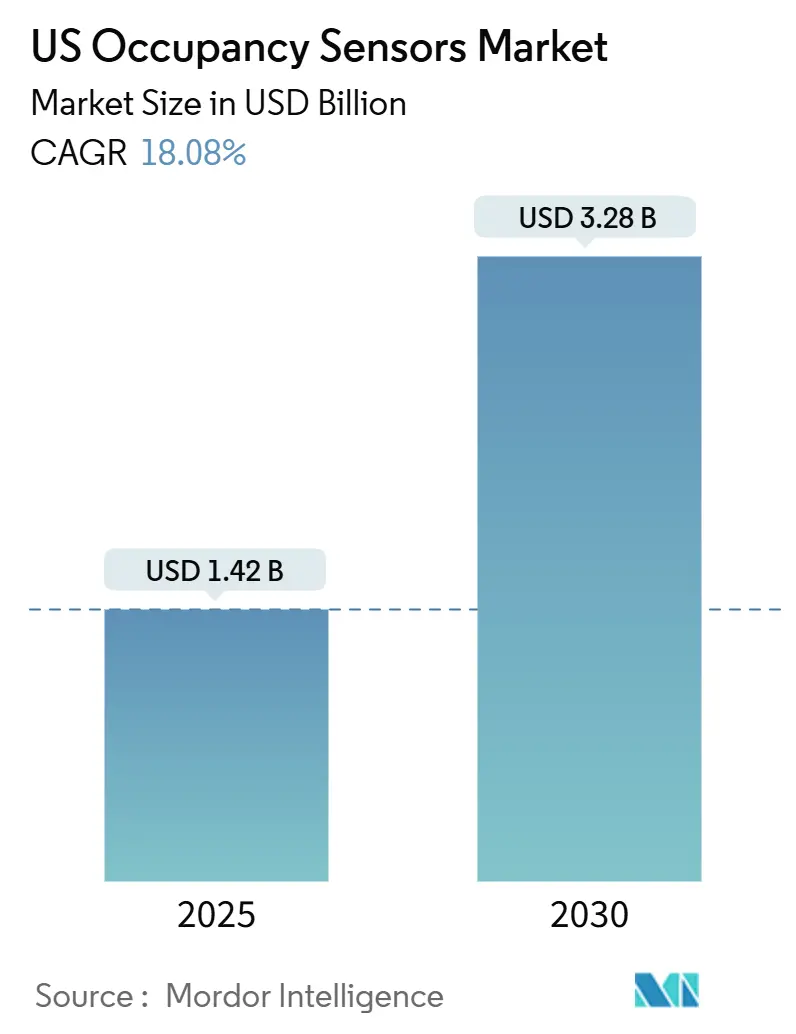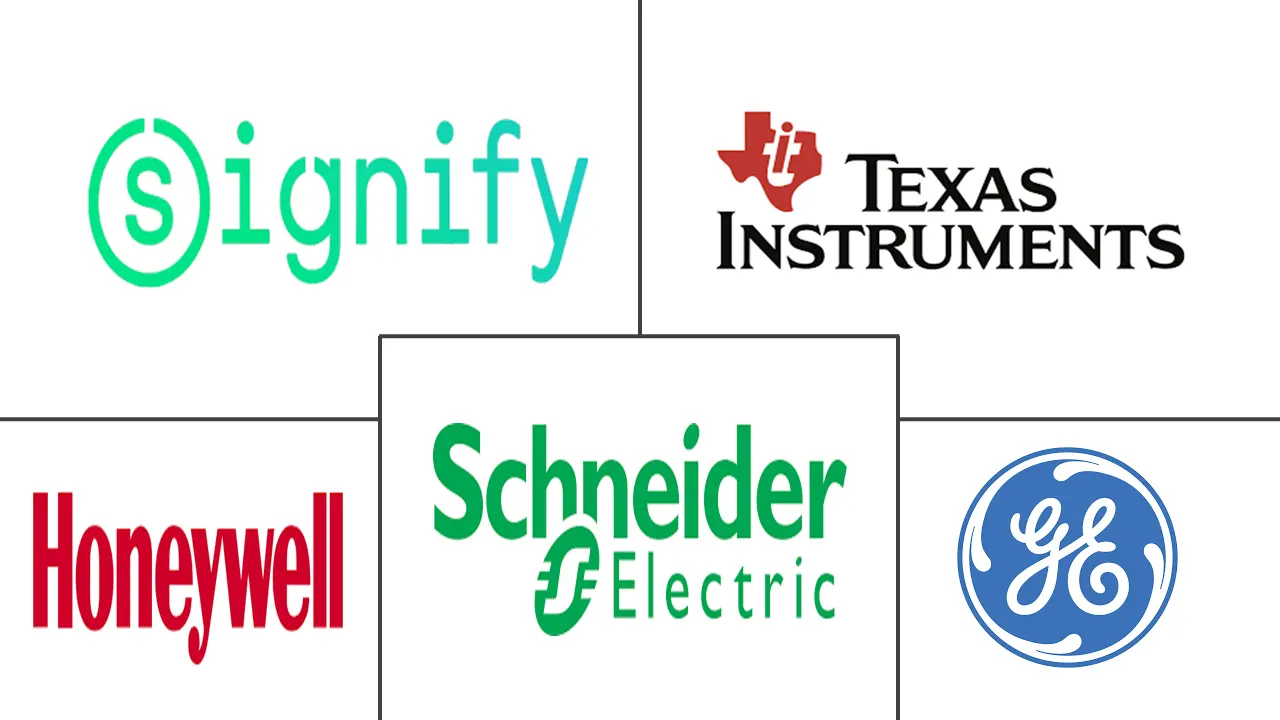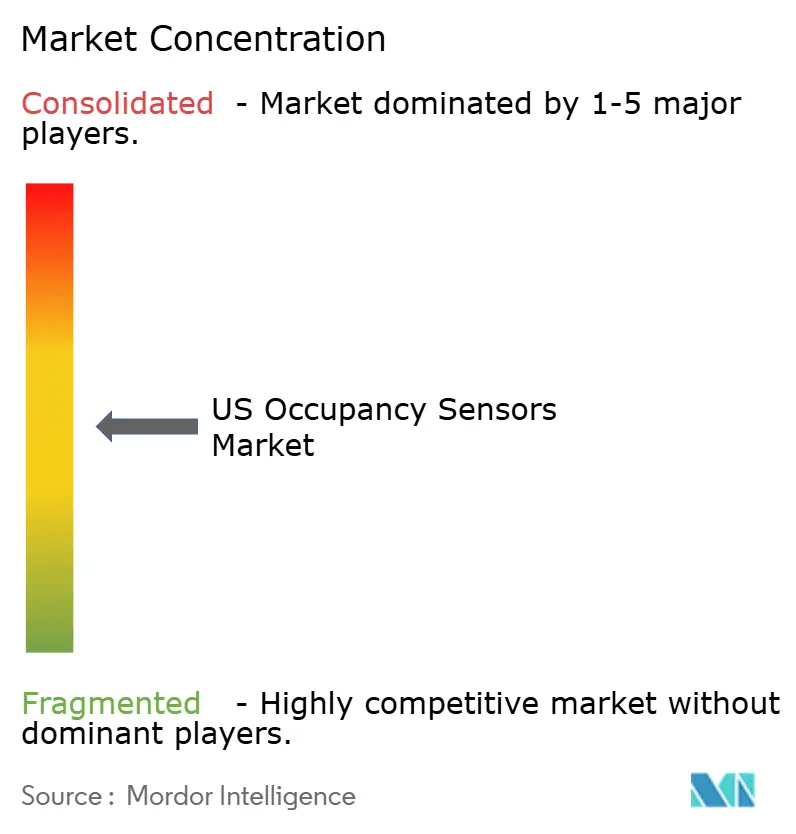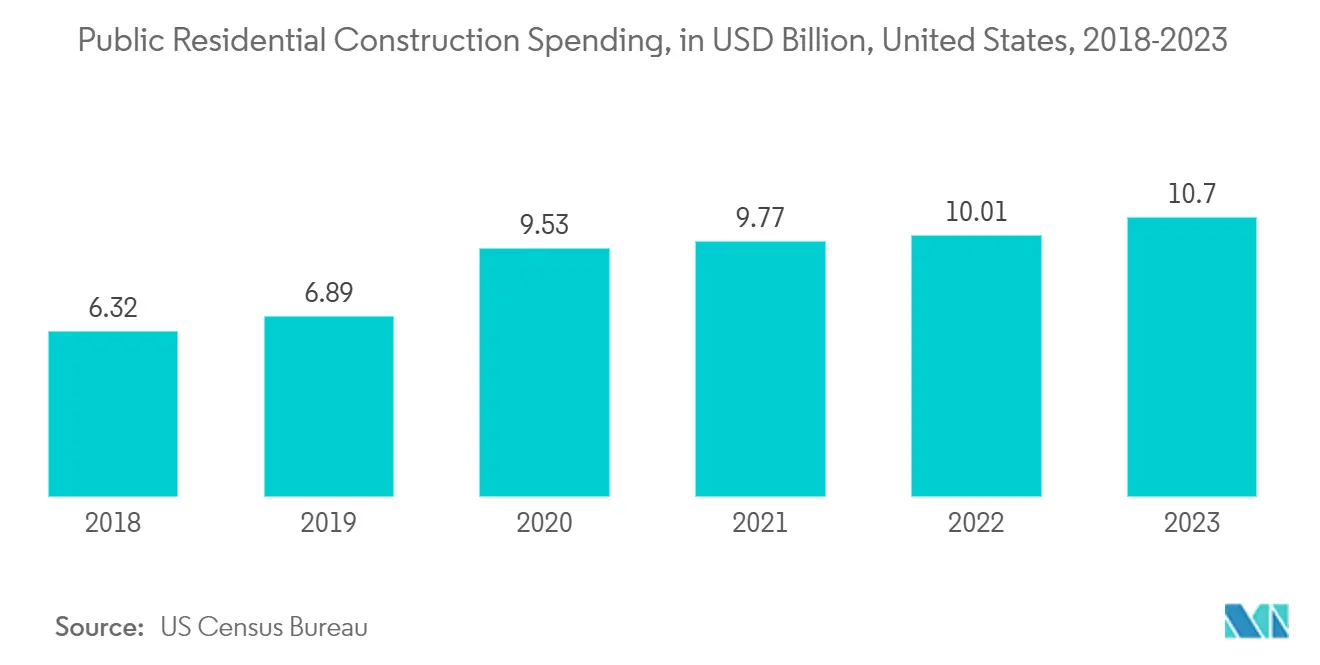
| Study Period | 2019 - 2030 |
| Base Year For Estimation | 2024 |
| Forecast Data Period | 2025 - 2030 |
| Market Size (2025) | USD 1.42 Billion |
| Market Size (2030) | USD 3.28 Billion |
| CAGR (2025 - 2030) | 18.08 % |
| Market Concentration | Medium |
Major Players
*Disclaimer: Major Players sorted in no particular order |
US Occupancy Sensors Market Analysis
The US Occupancy Sensors Market size is estimated at USD 1.42 billion in 2025, and is expected to reach USD 3.28 billion by 2030, at a CAGR of 18.08% during the forecast period (2025-2030).
- Smart building technology and occupancy sensors can provide real-time data, allowing to make better decisions for building management under the new guidelines of COVID-19. Whether saving space or improving hygiene, occupancy IoT sensors can help mobilize and optimize the back-to-work process.
- One of the major driving factors for the expansion of occupancy sensors is the trend of urbanization. There is a growing demand for energy efficiency across homes and offices. According to the United Nations Department of Economic and Social Affairs, 68% of the population will be living in cities by 2050, which will augment sustainable energy use.
- The rising demand for energy-efficient devices is expected to drive the country. Occupancy sensors play a vital role in reducing energy consumption. This is achieved through the sensors, which shut down devices and other equipment based on occupancy. These sensors help reduce light pollution and can be used for indoor and outdoor spaces.
- The demand for passive infrared is expected to continue in the country due to the low cost, demand for energy-efficient devices, and less power requirement. It has a range of applications, such as lighting, spectrometers, gas, and fire detection systems. Some of the significant benefits of passive infrared sensors are accurate movement detection, reliable triggering, and cost-efficiency. Vending machine designers, for instance, are now incorporating PIR sensors into their products so that their displays only light up when someone is standing in front of the unit or maybe waving their hand in front of a panel, which saves on operating costs.
- Partnerships and entry by global players into the country are also expected to shape the market landscape in the future. Recently, Austria-based Loxone entered the US market with a smart home automation control offering that features more than 150 SKUs of products, including occupancy sensors, temperature and humidity sensors.
- Moreover, the advent of advanced occupancy sensors, such as micro-phonics, intelligent occupancy sensors, image processing occupancy sensors, and the new vision-based intelligent occupancy sensor, for HVAC systems is fueling the growth of the occupancy sensor market.
- Further, many potential users perceive occupancy sensors as expensive investments without a clear understanding of their long-term benefits in energy savings and operational efficiency. This perception can slow down adoption rates, particularly in developing regions.
US Occupancy Sensors Market Trends
Residential Expected to Witness Significant Growth
- With the introduction of smart building technologies, facility managers now have access to robust tools to access accurate information about space occupancy rather than relying on estimates and approximations and occupancy sensors aiding in collecting data about space usage and optimizing space management decisions in the country.
- Also, switch from a traditional lighting control system to a smart lighting control system, which allows for wireless and even touchless lighting control through occupancy sensing, time scheduling, and voice control. All of this has opened up new opportunities for professional lighting control companies, which provide flexible solutions to homes.
- Further, Photoelectric infrared (PIR) sensors are the current standard for detecting occupancy presence in buildings. Smart thermostats use sensors to control heating and cooling based on occupancy. One significant issue is that these PIR sensors only detect individuals moving.
- Additionally, occupancy sensor and smart outlet reference designs help home automation device makers and developers accelerate time to market while lowering system cost and complexity. Developers can quickly advance from design concept to final product by leveraging these new, turnkey reference designs, including pre-certified wireless technology, open-source hardware design files, industry-standard software stacks, and proven test setups manufacturing methods.
HVAC Segment is Expected to Witness Significant Growth
- The demand for air conditioning in the commercial industry is growing. For instance, Comfort Systems USA, a prominent provider of mechanical services, including heating, ventilation, air conditioning (HVAC), plumbing, piping, and controls, announced that it has entered into a definitive agreement to acquire Walker TX Holding Company Inc. and its related subsidiaries headquartered in Texas. In addition, government regulations about energy efficiency and environment-friendly refrigerants are expected to create opportunities for the market over the forecast period.
- Additionally, In Atlanta, Samsung HVAC announced that it would expand its commercial air conditioning business by building, training, and supporting a network of specifying representatives, distributors, and installers. The company also announced expanding its Wind-free advanced cooling models for light commercial solutions. The surge in demand for HVACs is expected to drive the growth of occupancy sensors in the country.
- As per US Department of Energy, in 2023, the energy efficiency sector in the United States employed over 2.3 million workers. The country is focusing on smart city development to improve energy efficiency. The city of Newark, New Jersey, has onboarded Honeywell to install energy-efficient control solutions that incorporate the city’s HVAC, like room occupancy sensors and multi-location control of building systems. This is a part of the city’s Sustainability Action Plan. Initiatives such as these are expected to deliver significant savings in energy operations and hence drive exponential market demand.
- Another major driving factor for market expansion is a focus on innovation and advancements in occupancy sensors such as image processing occupancy sensors (IPOS), intelligent occupancy sensors (IOS), and micro-phonics. For instance, Panasonic introduced Low Profile Type PIR Motion Sensors offering a 10.9 mm profile alternative widely used in HVAC systems, smart homes, and surveillance systems.

US Occupancy Sensors Industry Overview
The United States Occupancy Sensors Market is moderately competitive in nature. Product launches, high expenses on research and development, partnerships, and acquisitions are the prime growth strategies adopted by the companies in the country to sustain the intense competition. Key players in the market are Signify Holding BV, Texas Instruments Inc., Schneider Electric SE, and others.
The trends in the U.S. occupancy sensor market indicate a robust trajectory towards smart building technologies that prioritize energy efficiency and sustainability. As urbanization continues and technological innovations emerge, occupancy sensors will play a pivotal role in shaping future building management practices.
US Occupancy Sensors Market Leaders
-
Signify Holding BV
-
Texas Instruments Inc
-
Schneider Electric SE
-
Honeywell Inc
-
General Electric Co
- *Disclaimer: Major Players sorted in no particular order

US Occupancy Sensors Market News
- November 2024: Kinematics, a global leader in intelligent motion control announced it has signed a definitive agreement to acquire P4Q, an industry leader in electronics for solar tracker controllers, industrial automation, sensors, and cloud-based monitoring.
- May 2024: Electronic Caregiver, a leading provider of digital health technology and service solutions, and Cognitive Systems Corp., creators of the world's leading Wi-Fi Sensing technology, announced a partnership to distribute CareAware, a WiFi Motion-based sensing solution, to enhance the aging-in-place experiences for older adults and caregivers.
US Occupancy Sensors Industry Segmentation
An occupancy sensor is used to save energy, comply with building codes, and provide automatic control and various other such applications. One of the most-used technologies among occupancy sensors is the passive infrared, which detects occupancy within a specific field, activates lighting, and is extremely useful in small spaces.
The United States Occupancy Sensors Market is segmented by network type (wired, wireless), technology (ultrasonic, passive infrared, microwave), application (lighting control, HVAC, security and surveillance), and building type (residential, commercial). The market sizes and forecasts are provided in terms of value (USD) for all the above segments.
| By Network Type | Wired |
| Wireless | |
| By Technology | Ultrasonic |
| Passive Infrared | |
| Microwave | |
| By Application | Lighting Control |
| HVAC | |
| Security and Surveillance | |
| By Building Type | Residential |
| Commercial |
US Occupancy Sensors Market Research FAQs
How big is the US Occupancy Sensors Market?
The US Occupancy Sensors Market size is expected to reach USD 1.42 billion in 2025 and grow at a CAGR of 18.08% to reach USD 3.28 billion by 2030.
What is the current US Occupancy Sensors Market size?
In 2025, the US Occupancy Sensors Market size is expected to reach USD 1.42 billion.
Who are the key players in US Occupancy Sensors Market?
Signify Holding BV, Texas Instruments Inc, Schneider Electric SE, Honeywell Inc and General Electric Co are the major companies operating in the US Occupancy Sensors Market.
What years does this US Occupancy Sensors Market cover, and what was the market size in 2024?
In 2024, the US Occupancy Sensors Market size was estimated at USD 1.16 billion. The report covers the US Occupancy Sensors Market historical market size for years: 2019, 2020, 2021, 2022, 2023 and 2024. The report also forecasts the US Occupancy Sensors Market size for years: 2025, 2026, 2027, 2028, 2029 and 2030.
Our Best Selling Reports
US Occupancy Sensors Industry Report
Statistics for the 2025 US Occupancy Sensors market share, size and revenue growth rate, created by Mordor Intelligence™ Industry Reports. US Occupancy Sensors analysis includes a market forecast outlook for 2025 to 2030 and historical overview. Get a sample of this industry analysis as a free report PDF download.





